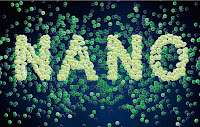Week VIII: Nanotechnology and Art
Not many people know just how prevalent nanotechnology is in the modern day world. It’s interesting to think how much of an effect nanotechnology has on our daily lives, and how little we know about it. I think we as a society know so little about this art, because of how invisible the innovations of nanotechnology are. To put it into perspective, nanotechnology can be found in everyday things such as cellphones, airplanes, sunscreen, and other things that we don’t really even think of.
Nanotechnology in products such as these has been credited to increasing the lifespan of the products, but it’s truly interesting to think about because how could we have ever really known? The best discoveries happen when people make observations. Because of the microscopic nature of nanotechnology, people don’t really understand how it works. To briefly explain, a nanoparticle is a microscopic object that is so small, it becomes completely naked to the human eye; the human eye can’t even see it.
Created in 1981 by Heinrich Rohrer and Gerd Binnig, the Scanning Tunneling Microscope was created to better understand the behaviors of the nanoparticles in objects. Nanoparticles have the ability to do many things. Often times, they’re even found in the medical world. One example can be found in a new cancer treatment drug. Patients will be injected with a medicine filled with silicon nanoparticles that will dissolve and potentially kill the cancer cells.
In this week’s readings, it was truly amazing to learn how obscure nanoparticles are. They don’t necessarily follow normal scientific principles! Gimzetwski states that it is important to recognize that nanoparticles don’t follow traditional behavior, and are autonomous. They self-assemble and self-organize. Scientists have tracked these behaviors to further understand the complexity of atoms, and have drawn parallels of these particles to that of snowflakes.
As stated in the readings, a shift of perception needs to happen in order for people to truly understand these particles. There can be so many amazing innovations if people were to be more accepting of this. Another medical discovery that was talked about in the readings is that of blood clots. Nano sponges travel through the bloodstream and are able to attract the toxins found in the blood. Because of this, it is easier to diagnose people.
Nanotechnology can also be found in art. It’s amazing to see how innovative people can be. Artist Kale Nochols combines these two things and creates colorful pieces of art that are made up of nanoparticles from paint.
The fact that these two things can come together and make something so amazing, is truly beautiful. This technology provides an endless amount of opportunities for the world - we just have to be open to them.
"Art in the age of nanotechnology." Art.Base. N.p., n.d. Web. 28 May 2017.
The Nanomeme Syndrome: Blurring of fact & fiction in the construction of a new science. N.p., n.d. Web. 28 May 2017.
Uconlineprogram. "Nanotech Jim pt1." YouTube. YouTube, 21 May 2012. Web. 28 May 2017.
Uconlineprogram. "Nanotech Jim pt2." YouTube. YouTube, 21 May 2012. Web. 28 May 2017.
Uconlineprogram. "Nanotech Jim pt4." YouTube. YouTube, 21 May 2012. Web. 28 May 2017.
Uconlineprogram. "Nanotech Jim pt5." YouTube. YouTube, 21 May 2012. Web. 28 May 2017.
Ouellette, Jennifer. "This Artist "Paints" With Nanoparticles Inspired by Butterfly Wings." Gizmodo. Gizmodo.com, 17 Dec. 2015. Web. 28 May 2017.
"Gel filled with nanosponges cleans up MRSA infections." Phys.org - News and Articles on Science and Technology. N.p., n.d. Web. 28 May 2017.
"A New Meaning of the Word 'Snowflake'." Merriam-Webster. Merriam-Webster, n.d. Web. 28 May 2017.




Sanam, great blog post this week. I liked how you connected how nanotechnology and art are created. Good examples from the readings about how obscure nanoparticles are. I also like your choice of pictures
ReplyDelete